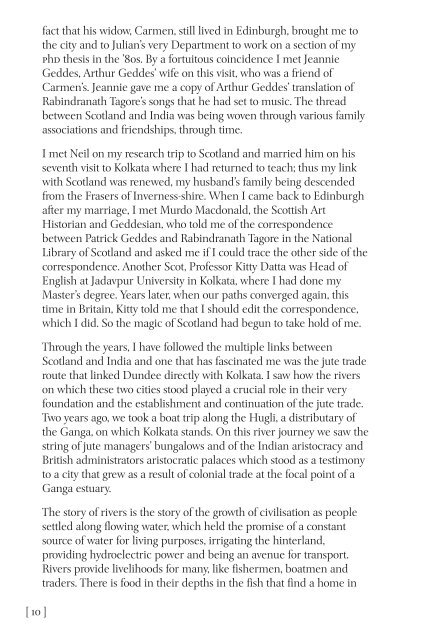From the Ganga to the Tay by Bashabi Fraser sampler
The Ganges and the Tay, the largest water courses in their two countries, are sources of life, conflict and industrial and historical change. The Ganga and the Tay is an epic concrete poem in which the River Ganges and the River Tay relate the historical importance of the ties between India and Scotland and their contemporary relevance as a natural symbol of continuity and peace. The poem is illustrated with beautiful photographs of both great rivers, which explore their shared, but unique, personalities through their histories, geographies, mythologies and environments.
The Ganges and the Tay, the largest water courses in their two countries, are sources of life, conflict and industrial and historical change. The Ganga and the Tay is an epic concrete poem in which the River Ganges and the River Tay relate the historical importance of the ties between India and Scotland and their contemporary relevance as a natural symbol of continuity and peace. The poem is illustrated with beautiful photographs of both great rivers, which explore their shared, but unique, personalities through their histories, geographies, mythologies and environments.
Create successful ePaper yourself
Turn your PDF publications into a flip-book with our unique Google optimized e-Paper software.
[ 10 ]<br />
fact that his widow, Carmen, still lived in Edinburgh, brought me <strong>to</strong><br />
<strong>the</strong> city and <strong>to</strong> Julian’s very Department <strong>to</strong> work on a section of my<br />
phd <strong>the</strong>sis in <strong>the</strong> ’80s. By a fortui<strong>to</strong>us coincidence I met Jeannie<br />
Geddes, Arthur Geddes’ wife on this visit, who was a friend of<br />
Carmen’s. Jeannie gave me a copy of Arthur Geddes’ translation of<br />
Rabindranath Tagore’s songs that he had set <strong>to</strong> music. The thread<br />
between Scotland and India was being woven through various family<br />
associations and friendships, through time.<br />
I met Neil on my research trip <strong>to</strong> Scotland and married him on his<br />
seventh visit <strong>to</strong> Kolkata where I had returned <strong>to</strong> teach; thus my link<br />
with Scotland was renewed, my husband’s family being descended<br />
from <strong>the</strong> <strong>Fraser</strong>s of Inverness-shire. When I came back <strong>to</strong> Edinburgh<br />
after my marriage, I met Murdo Macdonald, <strong>the</strong> Scottish Art<br />
His<strong>to</strong>rian and Geddesian, who <strong>to</strong>ld me of <strong>the</strong> correspondence<br />
between Patrick Geddes and Rabindranath Tagore in <strong>the</strong> National<br />
Library of Scotland and asked me if I could trace <strong>the</strong> o<strong>the</strong>r side of <strong>the</strong><br />
correspondence. Ano<strong>the</strong>r Scot, Professor Kitty Datta was Head of<br />
English at Jadavpur University in Kolkata, where I had done my<br />
Master’s degree. Years later, when our paths converged again, this<br />
time in Britain, Kitty <strong>to</strong>ld me that I should edit <strong>the</strong> correspondence,<br />
which I did. So <strong>the</strong> magic of Scotland had begun <strong>to</strong> take hold of me.<br />
Through <strong>the</strong> years, I have followed <strong>the</strong> multiple links between<br />
Scotland and India and one that has fascinated me was <strong>the</strong> jute trade<br />
route that linked Dundee directly with Kolkata. I saw how <strong>the</strong> rivers<br />
on which <strong>the</strong>se two cities s<strong>to</strong>od played a crucial role in <strong>the</strong>ir very<br />
foundation and <strong>the</strong> establishment and continuation of <strong>the</strong> jute trade.<br />
Two years ago, we <strong>to</strong>ok a boat trip along <strong>the</strong> Hugli, a distributary of<br />
<strong>the</strong> <strong>Ganga</strong>, on which Kolkata stands. On this river journey we saw <strong>the</strong><br />
string of jute managers’ bungalows and of <strong>the</strong> Indian aris<strong>to</strong>cracy and<br />
British administra<strong>to</strong>rs aris<strong>to</strong>cratic palaces which s<strong>to</strong>od as a testimony<br />
<strong>to</strong> a city that grew as a result of colonial trade at <strong>the</strong> focal point of a<br />
<strong>Ganga</strong> estuary.<br />
The s<strong>to</strong>ry of rivers is <strong>the</strong> s<strong>to</strong>ry of <strong>the</strong> growth of civilisation as people<br />
settled along flowing water, which held <strong>the</strong> promise of a constant<br />
source of water for living purposes, irrigating <strong>the</strong> hinterland,<br />
providing hydroelectric power and being an avenue for transport.<br />
Rivers provide livelihoods for many, like fishermen, boatmen and<br />
traders. There is food in <strong>the</strong>ir depths in <strong>the</strong> fish that find a home in


















